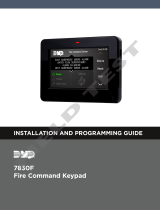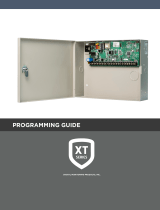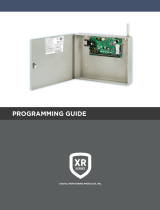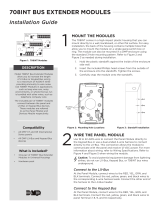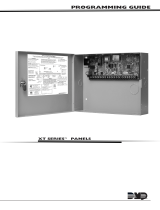Page is loading ...

TROUBLESHOOTING GUIDE
Tools, Tips, and Tests

Clearing System Messages .............12
Phone Line 1 Trouble ...................................................................... 12
Phone Line 1 Trouble - XT30/XT50 Panels ........................... 12
Phone Line 1 Trouble - XR150/XR550 PANELS ................... 12
Check Phone Line Voltage ................................................................ 12
Does PH LINE TRBL Clear? ............................................................... 12
4-Wire Bus Trouble ........................................................................ 13
Transmit Fail ......................................................................................13
What To Do .............................................................................................. 13
XR Series Panels .................................................................................... 13
XT Series Panels, iCom™, CellCom™, and DualCom™ ..............14
Transmit Trouble .................................................................................... 15
XR Series Panels .................................................................................... 15
XT Series Panels, iCom, CellCom, and DualCom ....................... 15
System Trouble ................................................................................15
System Busy ......................................................................................16
Non-Polled Address .............................................................................16
Battery Trouble ...................................................................................... 17
Tamper Trouble (XR Panels Only) ............................................ 17
Wireless Trouble .............................................................................. 18
Common Keypad Messages........................................................19
Common Troubleshooting ............20
Can’t Get Into Local Programming .........................................20
Panel Will Not Arm ......................................................................... 21
How an Area System Works ...................................................... 22
Display Does Not Clear After an Alarm ................................ 23
Can’t Silence Bell/Siren ............................................................... 23
Panel is Armed But Zones Do Not Trip ................................. 24
Can’t Disarm ....................................................................................24
Door Access Troubleshooting ...................................................24
Troubleshoot with the Transmitter Survey LED ................. 25
General Wireless Troubleshooting .......................................... 25
CONTENTS
Get Started ......................................... 1
The Art of Troubleshooting............................................................1
The First Things to Check .....................................................................1
Troubleshooting Tools ..................... 2
Digital Multimeter .............................................................................2
DMP Tech App™ and Dealer Admin™ ........................................2
System Analytics ...............................................................................2
Support Center (Tech App Only) ...............................................2
Things to Know ................................. 3
DMP Feature Codes .........................................................................3
Common Voltages ............................................................................3
Built-In Tools ..................................... 4
Onboard Diagnostics ...................................................................... 4
Accessing the Diagnostics Menu ............................................... 4
Maximum Auxiliary Power Outputs 5
Wiring an Auxiliary Power Supply ..............................................5
Resistor Values ...................................................................................5
Determine Resistor Values ........................................................... 6
Output Information ......................................................................... 6
Annunciator Outputs .......................................................................7
Addressing Devices ..........................................................................7
How the 866 Style W Notification Module Works ...............8
Troubleshoot the 866 ......................................................................8
Set Up the 867 LX-Bus Addressable Notification Module 9
Troubleshoot the 867 ....................................................................10
Verify a Correct Address ....................................................................10
Bell Relay Address ................................................................................10
Supervisory Address ............................................................................10
Metering Terminals ...............................................................................10
Troubleshoot the 1100T Wireless Translator .......................... 11

XR150/XR550 Diagnostics
Menu ................................................. 26
Test LX-Bus .......................................................................................26
Zone Finder ...................................................................................... 26
Zone State ........................................................................................ 27
LX-Bus Status .................................................................................. 27
X-Bus ................................................................................................... 28
MAC Address ................................................................................... 28
Serial Number .................................................................................. 28
Loader Version ................................................................................ 28
Current Flash ...................................................................................28
Communication Status ................................................................28
Cell Signal .........................................................................................28
Activate Cell ..................................................................................... 28
PC Programming ............................................................................ 28
Test Z-Wave ...................................................................................... 28
Wi-Fi Signal ...................................................................................... 28
Stop ..................................................................................................... 28
Network Diagnostics ......................29
Cell Status Failure Identification
Chart ................................................. 30
Finding and Handling Wiring
Issues ................................................. 31
Start with the Basics ...................................................................... 31
Identifying Wiring Issues without an AC Ground ............... 31
Troubleshooting Wiring Issues ..................................................31
DMP Sending Contact ID: Event
Definitions ....................................... 32
Loop Events & Zone Events ....................................................... 32
Disarming/Arming & Late to Close ......................................... 33
Door Access ..................................................................................... 33
Opening/Closing Schedule Changes ..................................... 33
System Messages without Restoral ........................................34
System Messages with Restoral ...............................................34

Troubleshooting Guide | Digital Monitoring Products 1
GET STARTED
This guide assists DMP Technical Support Technicians in helping DMP dealers troubleshoot and fixing any problems
they may have with DMP equipment. We now oer this guide to DMP dealers and technicians. Any text in this guide
within a paragraph or step that is capitalized and bolded indicates keypad display text.
The Art of Troubleshooting
When you’re troubleshooting at an installation site or on a service-call, your job is to get the equipment working
as quickly as possible. It is easy to overlook something simple when troubleshooting a system, so don’t skip the
basics. Perhaps something was overlooked in programming, or maybe something is physically incorrect, such as an
incorrectly placed panel-jumper, an unplugged transformer, or a harness on the wrong header.
The First Things to Check
When working with any manufacturer’s equipment, the key to troubleshooting is to know what questions to ask first.
In the case of a ‘dead’ keypad that has no display and does not respond when keys are pressed, check these items:
1. DC voltage at the keypad harness: Is the keypad getting power?
2. DC output on panel terminals 7 and 10: Is the panel supplying power?
3. Wire connections at panel terminals 7 and 10: Is the keypad connected to the panel correctly?
4. AC input on panel terminals 1 and 2: Is the panel getting AC power?
These are all correct troubleshooting steps for a ‘dead’ keypad. But the order in which these steps are taken can
change depending on the layout of your system.
If the keypad is in the same room as the panel, it may be easier to check terminals 7 and 10 for DC output first. If the
keypad is 1000 ft. away, start with checking the keypad’s wire harness for proper DC voltage.

Troubleshooting Guide | Digital Monitoring Products 2
TROUBLESHOOTING TOOLS
Digital Multimeter
For basic troubleshooting, you need a basic digital multi-meter that can measure AC voltage, DC voltage, Ohms (W)
and continuity. Keep a spare battery for your multimeter. When the meter’s battery is low, the meter may not give an
accurate reading which makes troubleshooting dicult due to misleading results.
DMP Tech App™ and Dealer Admin™
The Tech APP (Automatic Panel Programming) is a mobile tool that allows you to add, edit, and view customers,
systems, and app users. You have the ability to quickly adjust system programming directly from the app, as well
as access full programming and reporting options. Programming can then be pushed to a system, allowing you to
remotely program customer’s systems. To use the Tech APP, you must have a valid account username and password
given to you by a Dealer Admin administrator.
System Analytics
Contains system information such as:
1. Customer—The customer’s name.
2. Account—The customer’s account number.
3. System Name—The name of the customer’s system.
4. Type—The system type, such as XR150, XT30, XTLplus, CellCom, etc.
5. Software Version—The current system firmware version.
6. Cell Signal Information—Information about cell signal communication. This applies only to systems with an
active cellular module. For more information, refer to the appropriate DMP guides.
7. Retries—Information about communication retries. The information displayed depends on the system’s
connection type.
8. System and Battery Voltage—Information about system voltage and battery voltage.
Support Center (Tech App Only)
1. Installation Guide—View the system’s installation guide.
2. Programming Guide—View the system’s programming guide.
3. Troubleshooting Tools—View door access, keypad, cellular, and network error messages.
4. DMP Guides—View all of DMP’s product guides on the DMP website.
5. Email Pics—Take a picture of an installation to send to someone who can help you.
6. Contact Technical Support—Contact DMP technical support.

Troubleshooting Guide | Digital Monitoring Products 3
DMP FEATURE CODE MENU ITEMS
DMP FEATURE CODE SPELLING
Programmer Menu 6653 PROG
Diagnostics Menu 2313 DIAG
Walk Test Menu 8144 WALK
Keypad Options 3577 INST
Communication Test Menu 984
THINGS TO KNOW
DMP Feature Codes
All DMP panels use a number to access certain features.
Some of these features include the programmer menu,
diagnostic menu, and the walk-test function.
Most of these codes have a word-equivalent that can be
spelled out using the keys on the keypad:
Common Voltages
These operating voltages are the same across the entire XT30/XT50 and XR150/XR550 product-line:
OPERATIONAL PARAMETERS FOR
XR PANEL ZONES 1 - 8 & XT PANEL ZONES 1 - 9
ZONE
CONDITION
RESISTANCE
ON ZONE
VOLTAGE ON
+ TERMINAL
OPEN More than 1300 Ohms Above 2.0 VDC
NORMAL 600 - 1300 Ohms 1.2 - 2.0 VDC
SHORT Less than 600 Ohms Below 1.2 VDC
This chart shows the operational parameters for XR Series
panel zones 1 - 8 and XT Series panel zones 1 - 9 when
2.2K resistors are enabled on v193 or higher firmware.
ZONE VOLTAGES USING 2.2K Ω RESISTORS
STATE VOLTAGE
SHORT 0 - 2.1 VDC
NORMAL 2.2 - 2.9 VDC
OPEN ≥ 3 VDC
1. AC input (terminals 1 and 2) – 17.3 VAC (We include
16.5 VAC Power Supplies.)
2. Charging circuit output (terminals 3 and 4) –
13.9VDC
3. Auxiliary power output (terminals 7 and 10) –
13.8VDC
4. Panel data receive output YELLOW (terminals 8
and10) – approx. 4.5 VDC
5. Panel data transmit output GREEN (terminals 9
and10) – approx. – 3.5 VDC

Troubleshooting Guide | Digital Monitoring Products 4
BUILT-IN TOOLS
Onboard Diagnostics
Select DMP systems have several built-in diagnostic features that are accessible from a keypad and can assist
technicians when troubleshooting a system. These diagnostic functions allow you to test the communication integrity
of the LX-Bus™, identify the state of individual zones, test communication, and also display the present electrical state
of any zone.
The Diagnostics menu options include:
PANEL DIAGNOSTICS MENU
MENU OPTIONS XR SERIES XT30/50 XTL+
Diagnostics
Test LX-Bus
Zone Finder
Zone State
LX-Bus Status
X-Bus
MAC Address
Serial Number
Loader Version
Current Flash
Communication Status
Cellular Status
Cellular Signal Strength
Activate Cell*
Email Status
Panel Settings
PC Programming
Test Z-Wave
Initialize Z-Wave
Wi-Fi Signal
Stop
Accessing the Diagnostics Menu
1. Reset the panel using the RESET jumper unless it has been less than 30 minutes since either:
▶You were in Programming,
▶You were in the Diagnostics menu,
▶You powered up the panel, or
▶You last reset the panel.
2. Enter 2313 for an XT Series keypad or 2313 and CMD for an XR Series keypad. (2313 spells DIAG.)
3. The keypad displays DIAGNOSTICS. Press the CMD key to move forward through the Diagnostics menu.

Troubleshooting Guide | Digital Monitoring Products 5
MAXIMUM AUXILIARY POWER OUTPUTS
All DMP panels provide 12 VDC of auxiliary power for system accessories, such as keypads, zone expanders,
supervision modules, and intrusion detectors.
▶XR150 and XR550: 1500 mA (1.5 A)
▶XT30 and XT50: 500 mA (0.5 A)
Each device consumes a portion of the panel’s available auxiliary power. When the auxiliary power demand is too
great, the panel shuts down the auxiliary power circuit. That means that anything powered by the panel is now dead.
To take some of the load o of the panel, an auxiliary power supply can be used.
Wiring an Auxiliary Power Supply
+
Y
G
-
+
Y
G
-
+ -
N/C COM
Control Panel Devices
12 VDC Power Supply
Optional Sensor Reset Output
+
Y
G
-
+
Y
G
-
+ -
N/C COM
Control Panel Devices
12 VDC Power Supply
Optional Sensor Reset Output
The Sensor Reset Output can be used to reset 2-wire smoke detectors (wired to Model 715 zone expanders) by
dropping power to the bus for five seconds when a Sensor Reset is performed.
If that isn’t necessary, then the positive voltage may go directly from the power supply to the devices on the bus.
Note: Always be sure that the negative side of the auxiliary power supply is connected to the black wire of the
bus you are using it on.
Resistor Values
DMP panels use resistors of dierent values to control dierent system voltages, such as zone voltages and bell
supervision voltages.
RESISTOR VALUES DMP EQUIPMENT
1,000 Ohm Panel zones 1-8, 711 & 714 zone expanders, DMP keypad zones
3,300 Ohm Panel zone 9 (XT30/XT50), panel zone 9 & 10 (XR), all Model 715 zone expanders
10,000 Ohm 866 & 867 Bell Supervision
470k Ohm 1103 & 1114 Wireless Transmitters
2M Ohm 1115 with External Water Probe

Troubleshooting Guide | Digital Monitoring Products 6
Determine Resistor Values
The color code on the resistor shows the resistor values. With the Gold or Silver band positioned to the right, look at
the other color-bands from left to right.
The first color-band on the left determines the first number of the resistor’s value and the second color-band
determines the second number of the resistor’s value. The third color-band tells us how many zeros to put behind the
first two numbers.
The last band (either Gold or Silver) represents the resistor’s tolerance, meaning that the actual resistance can vary
above or below the value indicated by the color code.
Brown
Black
Red
Orange
Orange
Red
Brown
Black
Orange
Yellow
Violet
Yellow
Gold
Gold
Gold
Gold
1K 3.3K 10K 470K
Brown
Black
Red
Gold
4-Band Code
Black
Brown
Red
Orange
Yellow
Green
Blue
Violet
Gray
White
Gold
Silver
0
1
2
3
4
5
6
7
8
9
N/A
N/A
0
1
2
3
4
5
6
7
8
9
N/A
N/A
1Ω
10Ω
100Ω
1KΩ
10KΩ
100KΩ
1MΩ
10MΩ
N/A
N/A
0.1Ω
0.01Ω
N/A
± 1%
± 2%
N/A
N/A
± 0.5%
± 0.25%
± 0.10%
± 0.05%
N/A
± 5%
± 10%
(F)
(G)
(D)
(C)
(B)
(J)
(K)
COLOR FIRST BAND SECOND BAND MULTIPLIER TOLERANCE
Note: The resistor shown above has: Brown (= 1), Black (= 0), Red (= 2), and Gold (± 5%). So this resistor has a
value of 1,000 Ohms.
Output Information
1. Dry Contact Relays DMP Part #305.
2. Single pole, Double throw.
3. Rated at 1 Amp @ 30 VDC resistive.
4. May be activated by any of the following:
▶Zone Condition (Open/Short)
▶Output Schedule Manually from User Menu
▶Communication Fail
▶Armed Area Annunciation
▶Fire Alarm / Fire Trouble
▶Other System Conditions

Troubleshooting Guide | Digital Monitoring Products 7
Annunciator Outputs
Available on XT30/XT50 Series, XR150/XR550 Series, CellComLTE-V, iComSL, Dualcom, and 716 Output Expander.
1. Switch to GROUND when activated.
2. Do not provide voltage.
3. 50 mA resistive.
4. Activated by same conditions as Model 305 Dry Contact Relay
and Voltage outputs.
PANEL OUTPUT NUMBER
XR150/XR550 Series 3-6
XT30/XT50 Series 1-4
Addressing Devices
Setting Address on 7000 Series keypads
1. Press and hold the CMD and Back Arrow keys until SET BRIGHTNESS appears on display.
2. Enter 3577 (INST) and CMD.
3. Press key under KPD OPT (Keypad Options).
4. At CURRENT KEYPAD ADDRESS, press any top row select key.
5. Enter desired address. (Do not enter leading zeros.) Press CMD to scroll to next option.
6. At KEYPAD MODE, press select key under SUP for supervised or UNSUP for unsupervised operation. Press
CMD. Keypads should be left Supervised unless specifically needing to be Unsupervised.
7. At DEFAULT KEYPAD MSG, press select key, enter message to be displayed on top row of display, and press
CMD.
8. At ARM PANIC KEYS: PN EM FI, press select keys below each to enable. When enabled, each will appear as *PN
*EM *FI (report as Zones: PN=19, EM=29, FI=39). Press CMD.
9. ACTIVATE ZONE 2 BYPASS: NO is used with 7073 and 7873 keypads for Soft Shunt function. Press CMD.
10. RELOCK ON ZONE 2 CHANGE: NO is used with above keypads for relocking a door when the zone returns to a
normal state, instead of waiting for the strike time to expire.
11. ACTIVATE ZONE 3 REX: NO is used with above keypads for REX function. Press CMD.
12. At NO OF USER CODE DIGITS: 5, press top row key, press 4, and then press CMD for Home/Away or other
systems that require 4 digit codes. Press CMD.
13. ALL? NO YES DELAY: 2 is used for an Area system. When arming, ALL? YES NO is displayed on the keypad.
When NO or YES is not selected before this delay (1 to 9 seconds) expires, the keypad automatically selects
YES. Enter zero to disable this feature. Press the CMD key.
14. CARD OPTIONS DMP sets the card format used by the reader in the keypad. Press any select key for custom
option.
15. REQUIRE SITE CODE: NO determines if an access credential’s site code will be required.
16. NO COMM WITH PNL OFF defines the state of the door if the keypad loses communication with the panel.
Press any select key for more options.
17. For SYSTEM OPTIONS: AREA (Graphic touchscreen keypads only), set this to the same system type that is set
in System Options in the panel’s programming menu for proper shield operation.
18. At DEALER LOGO ADD DELETE (Graphic touchscreen keypads only), load or update the logo displayed on the
main screen.
19. At DEALER INFO ADD DELETE (Graphic touchscreen keypads only), load or update the contact information
stored in the keypad.
20. At KPD OPT KPD DIAG STOP, press select key under STOP.

Troubleshooting Guide | Digital Monitoring Products 8
How the 866 Style W Notification Module Works
The 866 uses the panel’s bell circuit to switch power from an external power source to sirens and other notification
devices. It also supervises the connection to the external power source. The most important thing to know with the
866 is which wires connect to the panel versus which wires connect to the power source.
Terminals 1 and 2 power the 866 module. The positive trigger on terminal 3 tells 2 and 4 to send voltage to 5 and 6.
1
2
3
4
5
6
7
8
+ power from panel
Power supply ground
& panel ground
+12v trigger
Power supply +
+ supplied by 4
when triggerd
Ground from 2
when triggered
Contacts to be wired
to a zone
Auxiliary Power to Panel Terminal 7
Ground to Panel Terminal 10
Alarm In to Panel Terminal 5
+ Bell Power In
+ Bell Out
- Bell Out
N/C Trouble Contact
N/C Trouble Contact
EOL
Trouble and Ground
10k Ohm EOL Resistor
DMP Part #308
866
Normal
Bell Silence
Troubleshoot the 866
TERMINALS RESULT
1 and 2 Shows +12 VDC or +24 VDC.
If no voltage shows between 1 and 2, make sure the ground and power are coming from the same
panel or power supply.
2 and 3 Shows approximately 0 to 1.2VDC when normal.
Shows +12VDC when tripped.
If using Horn Strobes, steady voltage on terminal 3 is required.
If the 866 should be tripping, +12VDC on 2 and 3 trigger it.
2 and 4 Shows +12VDC or +24VDC.
If power is coming from the panel bell, you will have 0-1.2V until the bell trips.
If there is no voltage on 2 and 4, there’s no power to power the bell output. Ground and power
should come from the same panel or power supply.
5 and 6 Shows negative volts while the 866 is normal (-6VDC or -12VDC) then +12VDC (or +24VDC) when
triggered.
If the bell is not tripping, strap out 5 and 6 with a 10K resistor and meter terminals 5 and 6 while
tripped.
If you are experiencing a delay when sounding, make sure the bell silence switch is normal and a
10K resistor is installed on terminals 5 and 6.
7 and 8 Shows continuity while normal.
If there is no 10K resistor on 5 and 6, this contact will show open.
If the Normally Closed contact on 7 and 8 is open make sure the silence switch is normal and that
there is a 10K on 5 and 6.

Troubleshooting Guide | Digital Monitoring Products 9
JUMPER SETTING RESULT
Steady On for duration of Bell Cuto time.
Pulsed One second on, one second o for duration of programmed Bell Cuto time.
Temporal Temporal Code 3 as defined in NFPA-72, section A-3-7.2(a).
(0.5 second on, 0.5 second o, 0.5 second on, 0.5 second o, 0.5 second on, 0.5 second o)
California Schools As defined in West’s Annotated California Code, section 32002
(Short, intermittent sounds for 10 seconds, and then o for 5 seconds.
Set Up the 867 LX-Bus Addressable Notification Module
1. Connect the 4-pin header to the LX-Bus.
2. Program the bell relay address as an output.
3. Program the supervisory address as a supervisory zone. When the output triggers, it sends the voltage from terminals 1 and 2
to terminals 3 and 4.
5
6
7
8
4
3
2
1
BELL
+ IN
BELL
- IN
BELL
+ OUT
BELL
- OUT
BELL
TRBL
BELL
TRBL
PS
MON
MON
ATN
BELL SILENCE
BELL NORMAL
MODEL
867
PS
TRBL
TENS ONES
TENS
SUPERVISORY ADDR
BELL ADDRESS
ONES
RING
STYL
DATA
RED
BLACK
BELL
TRBL
GND
FAULT
Bell Trouble LED
Power Supply Monitor LED
Ring Style Header
Bell Relay Address Switches
Supervisory Address Switches
Normal/Silence Switch
From 505-12 DC +
To N/C Trouble Contact
From 505-12 DC –
To Trouble Indicator (optional)
To Trouble Indicator (optional)
To N/C Trouble Contact
+
–
To Bell Output –
To Bell Output +
10k Ω EOL
S
S
S
S
S= Supervised Circuit
All circuits are power limted.
Monitors 3, 4, 7, and 8.
Data LED
STEADY
PULSE
TEMPORAL
CALIFORNIA SCHOOLS
On steady if 7 & 8 have an issue.
Blinking if receiving LX data.
Bell Power Monitor
Must fault to open.
N/C Contact to optional auxiliary trouble indicator
Bell Power In
Bell Power Out
RED
YELLOW
GREEN
BLACK
To additional LX-Bus Modules
To panel
Ground Fault LED
On steady if 3 & 4 have an issue.
On steady if 3 is contacting a ground.

Troubleshooting Guide | Digital Monitoring Products 10
Troubleshoot the 867
Verify a Correct Address
Verify that the arrow is on the correct address. Verify the tens that are on the board side and the ones that are on the
terminal side.
Bell Relay Address
This is programmed in Output Information (to identify where it is on the system and prevent overlapping with a zone)
and must be programmed where it needs to trigger from (Fire Alarm Output, Fire Bell Output, Groups, etc). Multiple
867 modules can have the same bell relay address if you want multiple 867s to trip at once.
Supervisory Address
The supervisory address allows the device to be programmed as a supervisory zone in Zone Information. Multiple
867s must have dierent supervisory addresses to allow supervision of each one independently.
Metering Terminals
TERMINALS RESULT
1 and 2 Shows +12 VDC or +24 VDC depending on the voltage or your power supply.
3 and 4 Shows negative volts while the 867 is normal and then show positive volts when triggered (+12 VDC or
+24 VDC). Issues with 3 and 4 will generate an alarm on the Supervisory Address.
5 and 6 Show continuity. This is an optional N/C contact that monitors terminals 3 and 4 (not a zone). Issues with
3 and 4 will report on the Supervisory Address regardless of if 5 and 6 are being used. If the N/C contact
on 5 and 6 is open make sure the silence switch is normal and that there is a 10k resistor on 3 and 4.
7 and 8 Shows 0 VDC if the N/C contact on the power supply is normal. If you get 5 VDC on 7 and 8, your power
supply trouble indicator is faulted or the wiring is not connected. This must fault to open to trip. Issues
with 7 and 8 will show a trouble on the supervisory address.

Troubleshooting Guide | Digital Monitoring Products 11
Troubleshoot the 1100T Wireless Translator
The translator requires a DMP wireless receiver, otherwise it will not work because it is not a receiver.
1. Verify the panel is Version 211 firmware or higher. If below Version 211, update the firmware of the panel.
2. Verify the 1100D/1100DH/1100DI or 1100X/1100XH on the panel is Version 207 or higher. The 1100T requires a
DMP receiver with Version 207 or higher.
Caution: The 1100R is not compatible with the 1100T.
3. Verify that the 1100T is programmed as a Device in the panel, that the Serial Number matches the Device, and
that the correct competitor wireless frequency is selected. See the 1100T Series Wireless Translator Installation
and Programming Guide: LT-2243.
4. Test the LED survey of the 1100T. If it fails the LED survey, the 1100T is not talking to the panel. Verify the Serial
Number is correct in Device Setup. If it is, try moving the 1100T and try to establish successful communication.
Once it passes the LED survey, then proceed to step 5.
5. Verify that zone programming is correct. Make sure the transmitter Serial Number matches what is
programmed in the panel. If programming is correct, perform the Standard Walk Test (STD) to see if the zones
are checking in. You can also try to add in the transmitter through the Learn process. If the transmitter fails to
Learn or does not trip on the Walk test proceed to Step 6.
Note: When using 7-digit serial numbers remember to add a leading 0.
6. If the transmitter is not communicating with the 1100T, check the Compatibility Guide for the 1100T to see if it
is supported. The guide does not show all devices that may work. Some devices will only work a certain way.
Refer to the notes section of the guide for more information.
7. If the transmitter is compatible but not learning into the panel and/or not appearing in the Walk test, then it is
not communicating to the 1100T. Confirm the transmitter’s battery voltages, bring the transmitter closer to the
1100T, and test again.
8. If the transmitter is still not communicating at this point, try some dierent wireless transmitters on the 1100T
and look for wireless equipment that could impact the competitor wireless signal.
+BAT- +12V-
-
+
Tamper Switch
Survey LED
MODEL 1100T
Non-DMP
Antenna
DMP Antenna
Charge Status
LED
Green
Status LED Red
Status LED

Troubleshooting Guide | Digital Monitoring Products 12
CLEARING SYSTEM MESSAGES
Here are some common system messages that may display on a keypad. A brief description of what the message
means and some basic troubleshooting tips are listed under each system message heading.
Phone Line 1 Trouble
PHONE LINE 1 TRBL or PHONE LINE 2 TRBL means that the panel detects a problem with the telephone line. Because
of hardware dierences between DMP residential models and DMP commercial models, PHONE LINE 1 TRBL or
PHONE LINE 2 TRBL can mean a couple of things.
RJ supervision for DMP XR200 panels is achieved by placing a jumper wire across pins 2 & 7 of the RJ-31X.
Phone Line 1 Trouble - XT30/XT50 Panels
Connect the RJ SUP header to an available zone on the panel.
When the telephone cable is removed, the keypad displays zone
trouble along with the zone name and produces a steady tone.
To correct this condition:
1. Check the RJ cable for continuity. There may be a broken
wire. If so, replace the RJ cable with DMP Model356-2.
2. Make sure that RJ-31X pin-out is correct as shown.
Pin 1
Pin 2
Pin 3
Pin 4 Pin 5
Pin 6
Pin 7
Pin 8
Pin 1 - Brown
Pin 2 - Blue
Pin 3 - Yellow
Pin 4 - Green (Tip)
Pin 5 - Red (Ring)
Pin 6 - Black
Pin 7 - Orange
Pin 8 - Gray
Phone Line 1 Trouble - XR150/XR550 PANELS
XR Series panels monitor telephone line voltage. When the voltage falls below 3 VDC, the panel generates a
PHONELINE 1 TRBL. If you are using a Model 893-A Dual Phone Line Module and the voltage falls below 3 VDC, the
panel generates a PHONE LINE 1 TRBL or PHONE LINE 2 TRBL, depending on which line has a problem. Here are
some things to check:
Check Phone Line Voltage
1. Set your multi-meter to DC voltage.
2. With the panel still connected to the RJ-31X, place meter-leads on pins 4 & 5. If properly wired for line seizure,
this should be your incoming dial tone.
3. Check voltage. When the panel is ON-HOOK (not dialing) this voltage should read somewhere between 45 and
55 VDC.
4. Make the panel go OFF-HOOK (remove and replace the tamper jumper) and read the phone line voltage again.
Note: If the phone line voltage drops below 3 VDC, the problem lies with the phone line. If it does not
drop below 3 VDC, try BYPASSING THE 893A. To do this:
▶Place a jumper wire across pins 2 & 7 of the RJ-31.
▶Disconnect the short RJ cable (between panel J3 and 893A) from the panel.
▶Unplug RJ cable from 893A’s MAIN (Remove BACKUP for PH LINE 2 TRBL), plug into panel’s dialer
connection.
▶Wait up to two minutes for PH LINE TRBL to clear.
Does PH LINE TRBL Clear?
▶YES - Replace 893A Module. Be sure to power down the panel first.
▶NO - Enter programming and initialize events. This should clear the display. Wait at least two minutes after
initializing events to make sure that the PH LINE TRBL does not return.
Note: Initializing events erases all events in the Event Buer.

Troubleshooting Guide | Digital Monitoring Products 13
4-Wire Bus Trouble
When the keypad displays 4-WIRE BUS TRBL it means that the panel has a problem communicating with the keypad
bus devices. 4-WIRE BUS TRBL is not an indication of LX-Bus issues. More specifically, when the panel polls the
keypad bus devices, they aren’t able to respond.
4-WIRE BUS TRBL only displays for the following reasons:
1. All keypad bus devices set to Unsupervised: Make sure at least one keypad bus device is set as Supervised.
2. Multiple keypad bus devices set to same Supervised address: Make sure that all keypad bus devices are
addressed correctly (all devices sharing an address must be set as UNSUPERVISED).
3. Low voltage or no voltage on the panel’s Yellow (receive) wire (terminal 8): Check data voltage (DC) across
terminals 8 & 10 at the panel and at the device. If the voltage is low or open, remove the wires from terminals
7-10 and check voltage again. If still low or open, reset the panel using the RESET jumper and check the
voltage again. If voltage is still low or open, remove all wiring (except AC power) and check again. This last step
is taken to make sure that transient voltage isn’t being fed into the panel from the field wiring.
Multiple UNSUPERVISED devices may share the same address, as long as:
▶All devices using the same address are set for UNSUPERVISED operation,
▶None of the devices using the same address are being used for zone expansion, and
▶There is sucient auxiliary power available to operate the devices. Auxiliary power may be provided by the
panel or an auxiliary power supply or both.
Transmit Fail
When the keypad displays TRANSMIT FAIL it means that the panel made 10 attempts to communicate with the
receiver, but was unsuccessful.
After the ten attempts have failed, the panel tries once every hour to send a TRANSMIT FAIL message to the receiver.
The keypad only displays TRANSMIT FAIL when a user disarms the system or when an unsuccessful SYSTEM TEST has
been initiated from the User Menu.
What To Do
1. Arm the system. Let the Exit Delay timer count all the way down, and then disarm the system. If communication
to the receiver has been restored (For example, the panel successfully communicated the TRANSMIT FAIL or
any other signal), this should clear the display.
2. Send a test signal.
XR Series Panels
To test cellular or network communication:
1. Enter the diagnostics menu (DIAG) and press CMD until COMM STATUS displays.
2. Press any select key and enter the number of the path to be tested.
To test phone line communication:
1. Enter the User Menu and press the CMD key until SYSTEM TEST? displays.
2. Press any Select key. Watch the keypad display. When it shows ATTEMPT NO: 1, the panel dials the first Phone
Number programmed in RECEIVER 1 PROG of Communication.
3. When the panel successfully communicates to the receiver, the keypad displays TRANSMIT OKAY. The panel
attempts to send this test signal up to 10 times.

Troubleshooting Guide | Digital Monitoring Products 14
XT Series Panels, iCom™, CellCom™, and DualCom™
To test cellular communication:
1. Enter the diagnostics menu (DIAG) and press CMD until CELL STATUS displays.
2. Press any select key to start the test.
To test a network connection:
1. Enter 984 and press CMD.
2. Select NET.
To test phone line communication:
1. Enter the User Menu and press CMD until the display reads SYSTEM TEST?.
2. Press any Select key. Watch the keypad display. When it shows ATTEMPT NO: 1, the panel dials the first Phone
Number programmed in RECEIVER 1 PROG of Communication.
3. When the panel successfully communicates to the receiver, the keypad display changes to TRANSMIT OKAY.
The panel attempts to send this test-signal up to 10 times.
▶Verify the phone numbers by calling them from a butt-set at the RJ-31 connected to the panel’s dialer
connection. Does a receiver answer? Are you sure it isn’t a fax machine?
▶If NO, find the correct phone number and program it into the panel.
▶If YES, verify with central station that it is the correct receiver for the panel’s programmed
communication format.
▶DD = DMP SCS-1R
▶NET = DMP SCS-1R or SCS-VR receiver
▶CID = DMP SCS-1R or any receiver that accepts Ademco Contact ID format
▶CELL = DMP SCS-1R or SCS-VR receiver
4. Verify that the phone numbers in communication are entered correctly.
▶Make sure that the panel is dialing the correct phone number.
▶Make sure that the panel doesn’t need to dial a ‘9’ or other digit to get an outside line.
▶Be sure to include any pauses the panel needs.
▶Enter a P before the phone number for a three-second pause in the dialing sequence.
▶Enter a D to make the panel wait for dial tone before dialing.
5. Verify the panel is wired for proper line seizure.
▶If a phone line is shared with house-phones, fax machine, or other equipment, the panel must have
proper line seizure. If the panel does not have line seizure and someone or something else is using the
phone line, the panel can’t use the line.

Troubleshooting Guide | Digital Monitoring Products 15
Transmit Trouble
When the keypad displays TRANSMIT TRBL it means that the panel had to make at least three attempts to
communicate to the receiver. The way to clear Transmit Trouble is to get the panel to communicate on the first or
second attempt.
XR Series Panels
1. To test cellular or network communication, enter the diagnostics menu (DIAG) and press CMD until
COMMSTATUS displays. Press any select key and enter the number of the path to be tested.
2. To test phone line communication, enter the User Menu; press the CMD key until the display reads
SYSTEMTEST?.
3. Press any Select key. Watch the keypad display. When it shows ATTEMPT NO: 1, the panel dials the first Phone
Number programmed in RECEIVER 1 PROG of Communication. When the panel successfully communicates to
the receiver, the keypad display changes to [TRANSMIT OKAY]. The panel attempts to send this test-signal up
to 10 times.
XT Series Panels, iCom, CellCom, and DualCom
1. To test cellular communication, enter the diagnostics menu (DIAG) and press CMD until CELL STATUS displays.
Press any select key to start the test.
2. To test a network connection, enter 984, press CMD and select NET.
3. To test phone line communication, enter the User Menu. Press the CMD key until the display reads
SYSTEMTEST?. Press any Select key. Watch the keypad display. When it shows ATTEMPT NO: 1, the panel dials
the first Phone Number programmed in RECEIVER 1 PROG of Communication. When the panel successfully
communicates to the receiver, the keypad display changes to [TRANSMIT OKAY]. The panel attempts to send
this test-signal up to 10 times.
If the panel is not communicating to the receiver within two attempts:
1. Check RJ-31X wiring for proper line seizure. If phone line is shared with house-phones, fax machine or other
equipment, proper line seizure is a must. If the panel does not have line seizure and someone or something else
is using the phone line, the panel can’t use the line.
2. Use a butt-set connected to the panel’s RJ-31X to call the receiver phone number as programmed in
COMMUNICATION > RECEIVER 1 PROG. Is it a working phone number? If not, program the panel with the
correct phone number.
3. Send another System Test to the receiver to verify that the communication is taking place within two attempts.
System Trouble
1. Low or no (open) voltage on the Green wire of the keypad bus.
2. Reset jumper shorting both pins of the RESET header.
3. Processor failure.

Troubleshooting Guide | Digital Monitoring Products 16
System Busy
SYSTEM BUSY can mean that the panel is busy with other communication. Reset the panel. If the display does not
clear, SYSTEM BUSY can also mean that the panel’s microprocessor is damaged.
A few things to check:
1. Make sure the RESET header is not shorted.
2. Make sure the green wire (terminal 9) is not shorted to the ground or any other wire.
If that doesn’t clear the display, try this:
1. Check DC voltage across terminals 8 & 10. Check DC voltage across terminals 9 & 10. If both measure at 5 VDC,
reset the panel and check the voltages again.
2. If both voltages still measure at 5 VDC, remove panel ground and remove all wiring from terminals 7, 8, 9, & 10.
3. Reset the panel. Check data voltages.
▶If both voltages still measure at 5 VDC, replace the panel.
▶If voltages are correct now, begin replacing terminal 7, 8, 9, & 10 wiring. Be sure to check data voltages
after each wire is replaced. By checking the voltages in this manner, you should be able to see when the
voltage problem occurs. When it does, the wire you just replaced is most likely to be the cause of the
problem or a device connected to that wire.
Non-Polled Address
When the keypad displays [NON POLLED ADDR] it means that the keypad’s address is not programmed in device
setup.
If only one keypad is connected to the system and the address is set to something other than ADDRESS 1, this is
almost sure to be the problem.
1. Set the keypad’s address to 1.
2. Exit Keypad Installer Options.
3. Check that the keypad is working correctly.
If there are multiple devices on the keypad bus,
1. Check the keypad’s address in the Keypad Installer Options.
2. If incorrect, change it. Exit Installer Options.
3. If the keypad still doesn’t work, enter 6653 (PROG) from a keypad that is working correctly.
4. Check DEVICE SETUP programming.
5. Verify the address is set to KPD (set to FIRE for Model 630F keypads) and exit Programming.
6. Check that the keypad is working correctly.

Troubleshooting Guide | Digital Monitoring Products 17
Battery Trouble
In a normal condition, the panel tests the backup battery every 3 minutes by performing a load-test on the battery.
This test lasts for 5 seconds. If the battery voltage falls below 11.9 VDC during this test, the panel generates a
BATTERY -TRBL. This signal is also sent to the central station. In the trouble condition, panel re-tests the battery
every 2 minutes. When the battery’s DC voltage rises to 12.6 VDC, the BATTERY -TRBL clears from the display and the
restoral is sent to the central station.
If the battery has been replaced and the trouble condition is still present, try getting into and out of Programming.
This re-starts the 3-minute load-test timer. This usually will clear the BATTERY -TRBL. If not, try these steps:
1. Remove the AC wiring from terminals 1 & 2, so that only the battery powers the panel.
2. Set your meter to DC voltage and place the leads on terminals 3 & 4.
3. If the voltage is below 11.9 VDC, then the panel sees the new battery in a trouble condition. You can wait for the
new battery to charge to 12.6 VDC or you can check the charging circuit.
4. If the voltage is above 11.9 VDC, replace AC wiring on terminals 1 & 2, remove battery leads from the battery.
Check DC voltage on terminals 3 & 4. You should see about 13.8 VDC (14.2 VDC max.) when the battery is
disconnected.
If you see less than 13.8 VDC on the panel’s battery terminals with the AC wiring attached and reading a correct
voltage, the panel’s charging circuit may be damaged. The panel needs to be repaired. Any time the battery voltage
falls below 10.2 VDC, the panel disconnects the battery. This is to prevent deep-discharge damage to the battery.
Tamper Trouble (XR Panels Only)
TAMPER –TRBL displays when the enclosure is opened or removed or the tamper header goes open, resulting in a
signal transmission to the central monitoring station.
▶If this occurs when one or more areas are armed, a tamper ALARM message is sent.
▶If this occurs when all areas are disarmed, a tamper TROUBLE message is sent. The tamper header is for use
with an optional DMP Model 306 Tamper Harness. The harness connects to one or more tamper switches
mounted inside the panel enclosure to detect unauthorized opening or removal of the enclosure.
To clear TAMPER -TRBL from the display:
1. When the panel tamper is not being used, a jumper should be placed on both pins of the tamper header.
2. When the Model 306 is installed, place a jumper on the tamper header.
3. If the display clears, close the tamper switch(es) and check the Model 306 for continuity. If harness or switches
are bad, replace the Model 306.
4. If the display does not clear, enter Programming and Initialize EVENTS. Exit Programming. If the trouble does
not clear the panel needs to be repaired.
Note: Initializing events erases all events in the Event Buer.
/




